YOSEMITE CONSERVANCY

Protecting Yosemite’s W ildlife
Tracking Black Bears in the Park
Songbird Science in Yosemite
Expert Insights on Sierra Nevada Red Foxes
Q&A with a Biologist about Yosemite’s Owls
AUTUMN.WINTER 2016 :: VOLUME 07.ISSUE 02
INSIDE
YOSEMITE CONSERVANCY COUNCIL MEMBERS
CHAIR
Philip L. Pillsbury Jr.*
VICE CHAIR
Bob Bennitt*
COUNCIL
Hollis & Matt Adams*
Jeanne & Michael Adams
Gretchen Augustyn
Susan & Bill Baribault
Meg & Bob Beck
Suzy & Bob Bennitt*
David Bowman & Gloria Miller
Tori & Bob Brant*
Marilyn & Allan Brown
Steve & Diane Ciesinski*
Sandy & Bob Comstock
Hal Cranston*
Carol & Manny Diaz
Leslie* & John Dorman*
Dave & Dana Dornsife*
Lisa & Craig Elliott
Kathy Fairbanks
Sandra & Bernard Fischbach
Cynthia & Bill Floyd*
Jim Freedman & Karine Joret
Susan & Don Fuhrer*
Bonnie Gregory
Rusty Gregory*
Karen & Steve Hanson
Chuck & Christy Holloway*
Christina Hurn & Richard Tassone
Jennifer & Gregory Johnson*
PRESIDENT & CEO
Frank Dean*
VICE PRESIDENT, CFO & COO
Jerry Edelbrock
Jean Lane
Walt Lemmermann*
Melody & Bob Lind
Sam & Cindy Livermore
Anahita & Jim Lovelace
Mark Marion & Sheila Grether-Marion
Patsy & Tim Marshall
Kirsten & Dan Miks
Robyn & Joe Miller
Janet Napolitano
Dick Otter & Judy Wilbur
Sharon & Philip Pillsbury*
Bill Reller
Pam & Rod Rempt
Frankie & Skip Rhodes*
Liz & Royal Robbins
Dave Rossetti & Jan Avent*
Lisa & Greg Stanger*
Jennifer & Russ Stanton*
Ann & George Sundby
Susan & Bill Urick
Clifford J. Walker*
Wally Wallner* & Jill Appenzeller
Jack Walston & Sue Estes
Phyllis Weber* & Art Baggett
YOSEMITE NATIONAL PARK
Acting Superintendent Woody Smeck
*Indicates Board of Trustees
MISSION
Providing for Yosemite’s future is our passion. We inspire people to support projects and programs that preserve and protect Yosemite National Park’s resources and enrich the visitor experience.
PRESIDENT’S NOTE
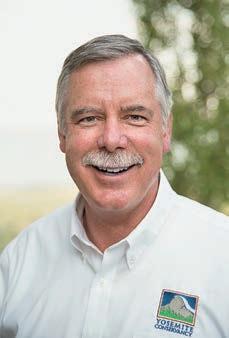
Yosemite is Wild at Heart
hen people think of national parks, spectacular scenery and good times usually come to mind. Our informal surveys show that park visitors also value seeing wildlife in their natural environment. Fortunately, Yosemite provides refuge for both people and wildlife. Despite the crowds in the Valley, the park’s wildlife is thriving in Yosemite’s exceptional habitat.
How do we know? Thanks to donor-supported research on indicator species, such as song birds, and on top-tier predators, such as great gray owls, scientists know more than ever. Your support has helped yellow-legged frogs return from the brink of extinction, reintroduced bighorn sheep to the heart of Yosemite, confirmed the presence of Sierra Nevada red foxes and much more.
Last year, as I walked across Ahwahnee Meadow, I heard a loud rustling sound, then watched as a yearling black bear bolted across the road to the Merced River. Fortunately, no cars were present. I was captivated by the grandeur, speed and pay-no-heed behavior of the bear in its natural environment.
In this issue, you will read how donor-funded bear research and tracking technology is saving bears by keeping them wild, as well as insights on several of Yosemite’s wild animals. You will also find revealing updates on other Conservancy programs and grants, and a gorgeous new Yosemite book.
This is all possible because of your generous support. Thank you! I hope you will enjoy the wild heart of Yosemite in the coming year, just like our beloved bears and expert Yosemite biologists. You deserve it!
Thanks for all you do for Yosemite!
Frank Dean, President
Follow Yosemite Conservancy, and stay connected.
Connect with us online!
02 AUTUMN.WINTER 2016 :: YOSEMITECONSERVANCY.ORG COVER PHOTO A black bear cub perches in a pine tree. PHOTO: © CAITLIN LEE-RONEY. PHOTO: (RIGHT) © YOSEMITE NATURE NOTES.

AUTUM.WINTER 2016 VOLUME 07.ISSUE 02
ABOVE Thanks to your support, endangered



04 PROTECTING YOSEMITE’S BEARS
The wildlife team uses the newest technology to track and protect Yosemite’s most iconic mammal.
08 THE SCIENCE OF SONGBIRDS
North America’s longest-running songbird research program is unlocking the secrets of migratory birds.
10 MEADOWS AND THE ANIMALS WHO LOVE THEM
Photos capture Yosemite’s beautiful meadows and the varied critters that call them home.
12 EXPER T INSIGHTS
Tracking the rare Sierra Nevada red fox, and other wildlife in their habitat, with wildlife biologist Stephanie Eyes.
14 Q&A WITH A YOSEMITE INSIDER
Researching Yosemite’s spotted owls and great gray owls with biologist Mike McDonald.
16 GRANT UPDATES
Peek at work-in-progress to preserve giant sequoias, count bighorn sheep, visit Yosemite’s Pioneer past and more.
21 PROGRAM UPDATES
Capture autumn color, learn about Yosemite’s natural history and pick up an inspiring new publication.
24 ANNU AL REPORT EXCERPT
Your gifts are making a difference in Yosemite.
26 WHY I GIVE
Conservancy donors share their stories of inspiration and passion.
30 READER PHOTOS
Yosemite Conservancy supporters share their special Yosemite memories.
IN THIS ISSUE DEPARTMENTS
CONTENTS
YOSEMITECONSERVANCY.ORG :: AUTUMN.WINTER 2016 03
Sierra Nevada bighorn sheep are making a comeback in Yosemite.
PROTECTING YOSEMITE’S
BEARS
PARK BIOLOGISTS USE GPS TO PROTECT A BELOVED SPECIES
lack bears are as iconic in Yosemite as granite domes and sequoias. They have foraged for berries, acorns and insects in Sierra forests and meadows since long before John Muir set foot in Yosemite Valley. Impressively strong and smart, these omnivorous creatures rarely attack humans and have never caused a serious injury in the park.
People, however, pose a notable threat to Yosemite’s bears. As visitors flocked to the park in the early 1900s, bears grew “food-conditioned,” quickly learning that campgrounds and parking areas meant easy access to calories. Trash-filled “bear pits,” designed to draw the animals away from campers’ food, became a popular tourist attraction. Unfortunately, bears’ dining habits became unhealthy and their search for food dangerously destructive.
Today, those pits are distant history, and Yosemite has a robust bearmanagement program focused on keeping bears wild and healthy. Since 1989, Conservancy donors have provided nearly $2 million for research and tools that have remarkably improved bear–human relationships in the park. Incidents (defined as a bear causing damage, stealing human food,

04 AUTUMN.WINTER 2016 :: YOSEMITECONSERVANCY.ORG
RIGHT Strong, smart and curious, black bears are adept at finding food in their natural environment — and in Yosemite’s developed areas. PHOTO: © CAITLIN LEE-RONEY.
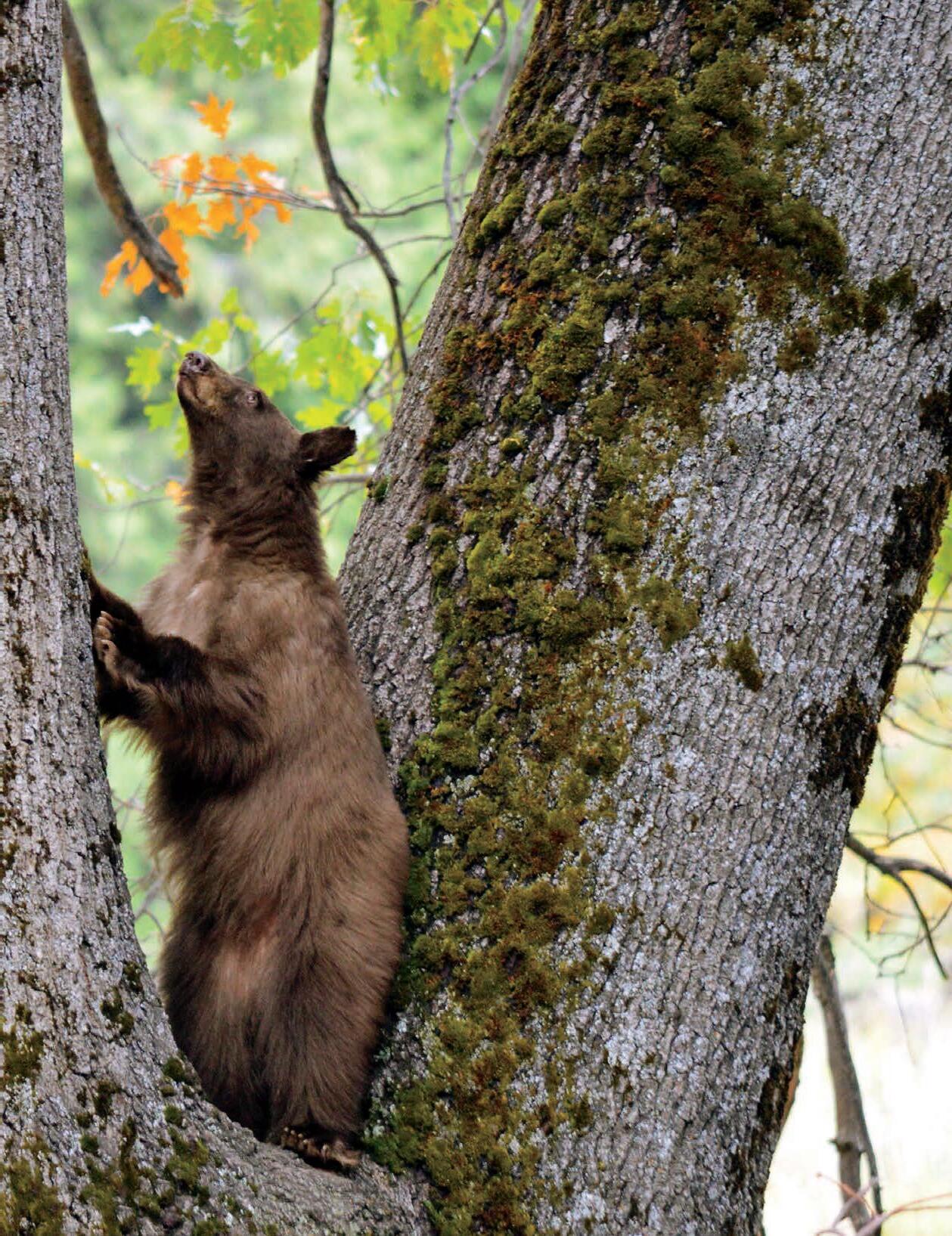
“The more we know about bears’ movements, the more we can work to reduce human–bear conflicts.”
—
CAITLIN LEE-RONEY Yosemite Wildlife Biologist
causing an injury or “bluff charging”) have dropped from a record high of nearly 1,600 in 1998 to fewer than 200 annually since 2011; in 2015, there were 76 incidents — a 40-year low.
Yosemite wildlife biologist Caitlin Lee-Roney, who started working with the bear program at age 17, has witnessed the transformation. In the early 2000s, she recalls, the team struggled to stay ahead of bear-related incidents: “Bears were in campgrounds almost nonstop. We would have 10 or more vehicle break-ins in a single night.”
Today, her team spends most of its time on prevention, not intervention. “We focus on educating people and preventing bear behavior from escalating,” Lee-Roney says. “When [bears] are not around people or development, we leave them alone, so they can be wild.”
BEHIND THE SCENES WITH THE BEAR TEAM
Yosemite’s bears and visitors share a “busy” season: spring through fall. Between May and August, the bear crew, operating in shifts, works 18 to 24 hours per day. Most days start with a look at data from battery-operated GPS bear collars, which were funded by Conservancy donors and allow the team to keep a close eye on bears that frequent developed areas.
Collaring a 200-pound wild animal is no easy task: Each

effort requires three to five people to capture, anesthetize, collar and release the bear. The GPS collars record locations hourly, allowing managers to monitor bears’ movements and respond as needed. The team uses the data to plan daily patrols and place staff in areas where human–bear encounters are likely. Bear near a campground? Head there to educate visitors about food storage, and chase the animal back into the woods, if needed. Bear near a road, causing a “bear jam”? Direct traffic, and remind people to stay a safe distance away.
In addition to informing the bear team’s day-to-day activities, GPS monitoring technology supports longterm management. Data from the collars informs efforts to reduce bear–vehicle collisions, prompts conversations with neighboring communities about preventing bear–human incidents, and offers insights into bears’ habitat and food preferences.
BIG-PICTURE BEAR MANAGEMENT
High-tech tools and active monitoring are crucial to Yosemite’s bear program, but the team cannot protect this iconic species alone. Visitors make crucial contributions to successful wildlife management by observing animals from a distance, watching for bears and other animals on park roads, and keeping food out of reach.

06 AUTUMN.WINTER 2016 :: YOSEMITECONSERVANCY.ORG
PHOTOS: (LEFT) © WHARTON MEDIA. (MIDDLE & RIGHT) © CAITLIN LEE-RONEY.
LEFT Yosemite’s new interactive bear website will include a map, shown here in draft form, that tracks collared bears (red) and those struck by vehicles (brown). MIDDLE The slim GPS collar fitted around this bear’s neck transmits hourly data to wildlife managers, and detaches after two years.
Throughout the years, the Conservancy community has played a big part in helping the public pitch in to protect bears. Donors have funded nearly 2,000 bear-proof food lockers distributed at trailheads and developed areas throughout the park. Our Wilderness team helps backpackers rent sturdy canisters to store food and scented items in the backcountry. Visitors learn about Yosemite’s bears through “Keep Bears Wild” items sold in our bookstores. With your support, the park’s bear team is building a website to educate people about our shared role in protecting bears and other wildlife in the park.
The Yosemite bear team’s ongoing efforts — and your generous contributions — are paying off: As of July 2016, incidents were trending even lower, down by 56 percent from record low levels in 2015. But there’s still work to do. Midway through the year, 24 bears had been hit by cars; seven were killed on impact. One of those fatalities resulted in three orphaned cubs.
We all have a role to play in ensuring these charismatic, curious forest-dwellers can continue to grow, forage and roam in the Yosemite Wilderness. Thanks to your help, generations to come will be able to see bears not in parking lots or campgrounds, but sauntering through meadows and trees, crunching acorns or clawing insects out of tree bark, as wild animals in their wild home.

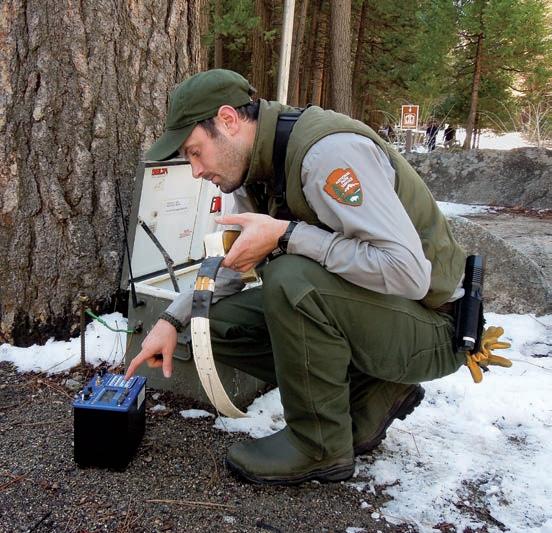
BLACK BEAR FACTS
Fast sprinters. Agile climbers. Superb smellers. Want to know more about these animal superstars? Read on to boost your ursine IQ.
Biologists estimate that 300–500 black bears live in Yosemite National Park.
An average bear weights 150 (female) to 250 (male) pounds.
Despite their name, black bears are usually brown, blond or reddish in color.
Black bears keep a largely vegetarian diet, primarily eating grasses, berries and acorns, as well as some ants, termites and insect larvae.
In the fall, bears eat up to 20,000 calories per day to prepare for hibernation.
If you encounter a bear, stay at least 50 yards away.
Yosemite has seen a 95% reduction in bear incidents since 1998. A bear incident occurs when a bear causes monetary loss (damaged property or stolen food) or, more rarely, injury to a person.
To report a bear sighting, no matter where or what the animal is doing, call 209-372-0322, or email yose_bear_mgmt@nps.gov. Learn more at nps.gov/yose/learn/nature/bears
YOSEMITECONSERVANCY.ORG :: AUTUMN.WINTER 2016 07
150 lbs. 250 lbs. FEMALE MALE 50 YARDS
RIGHT A Yosemite biologist checks on the electronic monitoring equipment that alerts the wildlife staff when bears are close to campgrounds.
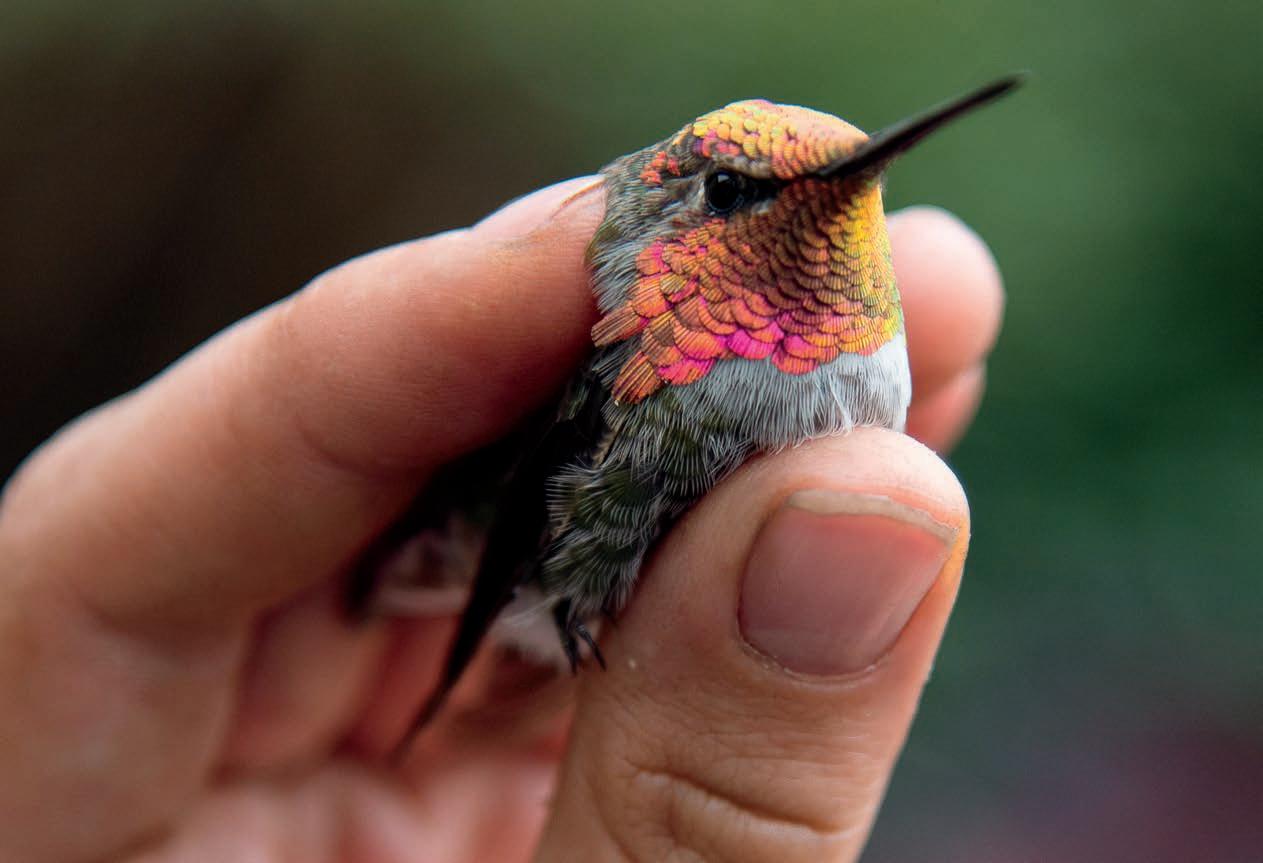
THE SCIENCE OF
SONG BIRDS
New insights from a long-running research program
day on Yosemite’s bird crew starts before dawn, with a headlamp-lit hike through a meadow to unfurl soft nylon nets, wait for feathered study subjects and uphold a long-running tradition. Yosemite’s songbird–research program launched in 1990; today, its five bird-banding stations are responsible for the most extensive songbird data in the national park system.
Grants funded by Yosemite Conservancy donors spanning 19 of the program’s 27 years have allowed the bird crew to study rare species, understand the importance of wildfire, record some of North America’s oldest birds, and document how avian demographics are shifting, as environmental conditions change. Recent work, for example, revealed that at least one species, the willow flycatcher, no longer breeds in the park.
08 AUTUMN.WINTER 2016 :: YOSEMITECONSERVANCY.ORG ABOVE Using special tools— and gentle hands —biologists study delicate songbirds to answer important questions about ecosystems in Yosemite and beyond.
The research has widespread implications. “When it comes to understanding and protecting the ecological health of the park, birds represent a critical piece of the puzzle,” Yosemite biologist Sarah Stock says.
Studying these living puzzle pieces requires long hours, specialized tools and steady hands. Between 6 am and noon, the bird crew follows a careful routine: Check nets for birds; gently remove each bird; record its species, age, sex and weight; place a numbered aluminum band around its leg; release the bird; head back to the nets.
Early meadow mornings add up. In 2015, the crew collected data on 1,872 individual birds representing 68 species. Among those studied was one of eight black-headed grosbeaks that had been outfitted with tiny GPS “backpacks” in 2014. Data from the retrieved device revealed the bird had paused on its journey south to shed feathers, making it a “molt-migrant.” When the crew recaptured a second backpack-bearing grosbeak in June 2016, an identical path emerged.
The grosbeak discovery underscores why Yosemite’s birdbanding research matters beyond park borders. Songbird journeys and demographics provide important clues to environmental changes in the Sierra and across the West. Climate change could lead to a mismatch between migration schedules and food availability for grosbeaks and other molt-migrants.

“Birds are indicators of environmental conditions and tell us about Yosemite’s future in a changing climate.”
— SARAH STOCK Yosemite Wildlife Biologist
“Birds are indicators of environmental conditions and tell us about Yosemite’s future in a changing climate,” Stock says. As park researchers use avian clues to understand current and potential environmental shifts, they’re committed to engaging more people, including interns, school groups and Conservancy Outdoor Adventures participants, in songbird science. Everyone who spends time at Yosemite’s birdbanding stations, whether scientist, fourth-grader or park visitor, leaves with a deep sense of the program’s value — and of the need to preserve the park as a sanctuary for songbirds and other wildlife. Thanks to you, scientists are expanding a rich data set and helping to ensure Yosemite continues to serve as a haven, where birds and habitats are protected for generations to come.

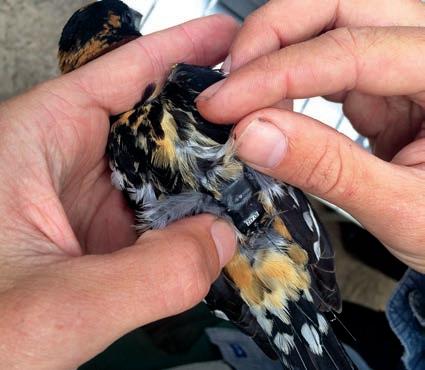
TRACKABLE BACKPACKS
Black-headed grosbeaks breed in Yosemite and migrate south in late summer. Thanks to your support, the park’s bird team has mapped the species’ path using miniature GPS-equipped “backpacks.” An unusual pattern emerged: After leaving Yosemite, the birds pause to molt their feathers in northern Mexico before continuing to their winter grounds.
YOSEMITECONSERVANCY.ORG :: AUTUMN.WINTER 2016 09 PHOTOS: (LEFT) © LAUREL HOUSTON. (BOTTOM LEFT TO RIGHT) © MARIE READ. © ANNA WEBER. © LAUREL HOUSTON.
Meadows and the Animals Who Love Them
he next time you stop for a photo or picnic alongside one of Yosemite’s mountain-framed meadows, take a moment to observe the diverse life thriving in such a seemingly simple place. Grasses and wildflowers intertwine in a lush carpet. Butterflies and bees zip among blooms. Birds and toads provide a natural soundtrack.
For years, our donors have supported grants to preserve meadows throughout the park, restoring critical habitat fragmented by social trails, invasive plants, pavement and more. Your continued support ensures Yosemite remains a haven for species that rely on meadows, from monkeyflower to monarchs and, ultimately, humans.


MONARCH BUTTERFLIES depend on milkweed. This crucial plant, the exclusive food source for monarch caterpillars, is declining nationwide. Donor-funded efforts to expand Yosemite’s milkweed population could help monarchs thrive in and beyond the park.


10 AUTUMN.WINTER 2016 :: YOSEMITECONSERVANCY.ORG
PHOTOS: (MEADOW) © ROBB HIRSCH, COURTESY THE TRUST FOR PUBLIC LAND. (HUMMINGBIRD) © BITEYOURBUM.COM PHOTOGRAPHY. (MONARCH BUTTERFLY) © YOSEMITE CONSERVANCY. (GREAT GRAY OWL) © CONSERVANCY DONORS ANN & ROB SIMPSON.
GREAT GRAY OWLS live along meadow margins, nesting in mature trees and hunting rodents among tall grasses. Thanks to you, Ackerson Meadow, home to the Sierra’s largest population of these endangered birds, is now protected as part of Yosemite.
HUMMINGBIRDS feast on nectar, pollinating flowers in the process. As meadows on unprotected land face threats from increasing development, Yosemite’s meadows provide a safe haven for these small, yet tremendously important, animals.

DANDELION (Taraxacum officinale) and other invasive plants out-compete native flora, disrupting the wetland habitat and food sources on which many species depend. Donor-supported efforts to remove invasives improve the resilience of Yosemite’s meadows.

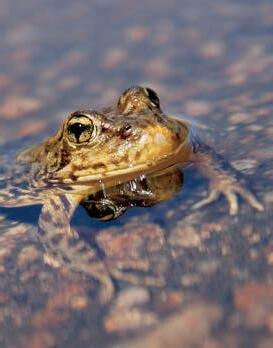
THE YOSEMITE TOAD, found only within a 150-mile span of the Sierra Nevada, relies on high-elevation wetlands to breed and feed. This threatened species is bouncing back, thanks to donor-funded meadow-restoration projects.
YOSEMITE’S SIERRA NEVADA
YELLOW-LEGGED FROGS are getting a boost through careful management. Meanwhile, thanks to your support, crews are working in Lyell Canyon, Tuolumne Meadows and elsewhere to restore habitat on which this endangered species relies.


YOSEMITECONSERVANCY.ORG :: AUTUMN.WINTER 2016 11
(DANDELION) © COURTESY OF NPS. (YOSEMITE TOAD) © LUCAS WILKINSON. (YELLOW-LEGGED FROG) © MICHAEL HERNANDEZ.

ABOVE Remote cameras and genetic samples allow scientists to study a rare mammal: the Sierra Nevada red fox (pictured here in northern California). MIDDLE This motion-capture image, taken in December 2014, confirmed the presence of the Sierra Nevada red fox in Yosemite. RIGHT Carnivores, such as bobcats and coyotes, compete with red foxes for prey.
FAR RIGHT A member of the wildlife crew checks a motion-capture camera in Yosemite’s high country.

SIERRA NEVADA RED FOXES
TRACKING YOSEMITE’S HIGH-ALTITUDE MAMMALS
BY STEPHANIE EYES, WILDLIFE BIOLOGIST, YOSEMITE NATIONAL PARK
any have heard the exciting news about a Sierra Nevada red fox with a long, fluffy, white-tipped tail frolicking through the snow for the first time in Yosemite National Park in nearly 100 years. Since that first photograph, taken in December 2014, cameras have provided more photos of foxes in two new locations in Yosemite!
Now that we know there are foxes here, we are working closely with our collaborators at UC Davis, the California Department of Fish and Wildlife, Central Sierra Environmental Resource Center and the US Forest Service to build on existing knowledge and answer new questions about Sierra Nevada red foxes and other wildlife in their habitat.
Yosemite’s red foxes are threatened under the state’s Endangered Species Act and consist of a small, isolated population of fewer than 50 individuals. The population faces many threats, including habitat loss, a decrease in prey species (small rodents and snowshoe hares), and competition from coyotes and genetic inbreeding.
12 AUTUMN.WINTER 2016 :: YOSEMITECONSERVANCY.ORG
EXPERT INSIGHTS



Non-native red foxes (initially brought over for fur-farming and later released) are being found at higher elevations and interbreeding with Sierra Nevada red foxes, increasing the risk of losing the Sierra Nevada red foxes’ unique genetic composition. Coyotes have also been documented at higher elevations in recent years. Red foxes tend to exclude themselves from areas with coyotes, so upward coyote movement is a cause for concern for this high-elevation-dwelling mammal. Complex issues such as this inspire many questions and often require extensive field work to collect data.
Motion-activated cameras are a great tool to help us answer some of these questions. After a long winter of waiting, our team recovers the cameras’ SD cards and may flip through thousands of photos searching for any indication of an animal. Many images are triggered by wind, sunlight, shadows or precipitation; but we do catch images of the rare Sierra Nevada red fox, bobcats above 10,000 feet, curious mountain lions exploring higher elevations, playful Douglas squirrels active all winter, snowshoe hares, white-tailed jackrabbits and a little-studied critter in the Sierra Nevada: a porcupine!
We also collect animal scat (feces) and hair for our partners at UC Davis to examine. Through DNA extraction, we can figure out the number of foxes, their origins, whether they are inter-breeding and what they’re eating.
The data we collect helps the future of a rare animal native to Yosemite. On behalf of the wildlife team, thank you, Conservancy donors, for contributing to science that will help us keep Sierra Nevada red foxes roaming the alpine for years to come!

PROJECT SUMMARY
With support from a Conservancy donor–funded project on rare carnivores, biologists recently reported the first sighting of a Sierra Nevada red fox in Yosemite in nearly a century. This year, biologists are using motion-activated cameras, “hair snare” stations and scat surveys to learn about the fox population’s geographic distribution and genetic makeup. Scientists are also studying the animals that share the fox’s habitat, including competitors, such as coyotes and bobcats, and prey, such as Douglas squirrels. This research will help inform efforts to protect the Sierra Nevada red fox, ultimately leading to a self-sustaining population of the species in Yosemite.

STEPHANIE EYES is a wildlife biologist in Yosemite, overseeing the park’s owl- and carnivore-monitoring programs. She has been a National Park Service employee since 2014 and previously worked in Yosemite for the US Geological Survey. Eyes received her MS degree from Humboldt State University, studying the effects of fire severity on Yosemite’s spotted owls. While finishing her master’s degree, Stephanie worked for the US Forest Service, monitoring the Pacific fisher population south of the park. Her previous experience includes monitoring reintroduced bald eagles at Channel Islands National Park and observing migrating raptors in southwestern Wyoming.
YOSEMITECONSERVANCY.ORG :: AUTUMN.WINTER 2016 13
EXPERT INSIGHTS
PHOTOS: (RED FOX IN GRASS) © KEITH SLAUSEN. (RED FOX IN SNOW, BOBCAT, WILDLIFE CREW & STEPHANIE EYES) © COURTESY OF NPS. (COYOTE) © CLAIRE F. MEYLER.
“Anytime someone is lucky enough to see an owl in the park, they can thank Conservancy donors.”
— MIKE M c DONALD Wildlife Biologist & Field Crew Lead for Owl Research
Q&A
As
iologist Mike McDonald is passionate about protecting Yosemite National Park’s wildlife. Since 2004, he’s worked on wildlife projects in the park. In his present job as co-lead of the owl research field crew, McDonald directs a team of biologists collecting data on two sensitive owl species: great gray owls and spotted owls. Reporting to wildlife biologist Sarah Stock, McDonald’s team provides much-needed information to guide wildlife management in protecting these iconic species.
Q :: What do you love about working as a biologist in Yosemite?
A :: I feel connected to the species we study. The spotted owls and great gray owls are very charismatic. You can look at them and imagine you know what they’re thinking. Plus, it’s exciting to work in the woods at night. We call to the owls with our voices, and they respond. We observe them hunting and defending their territories. They’re beautiful animals and easy to love.
Q :: What little-known facts about these owls might surprise our readers?
A :: I’am always impressed by how the spotted owls are so
WITH A YOSEMITE INSIDER

long-lived, monogamous and territorial. One owl in Yosemite was seen in the same territory for more than a decade. It’s really beautiful that they know this patch of forest so well.
Great gray owls are similarly faithful and long-lived. They are visually the largest owls in North America, but not the heaviest. They’re mostly feather, so they don’t weigh as much as you might think.
Q :: Why is it important to preserve the great gray owls and spotted owls in Yosemite?
A :: Yosemite’s great gray owls are an isolated, distinct subspecies of the great gray species. Though the population has persisted for millennia, it is tiny in number — and endangered. Having a protected area such as Yosemite is a huge boon to the protection of the species.
The California spotted owl is also a protected species. The data we’re gathering helps managers make decisions to keep these species around forever.
Q :: What have you learned about these species through Conservancy donor–funded research?
A :: We are learning some key things about Yosemite’s owls, such as how many owls live in the park, their habitat requirements and their resiliency to fire. [Biologists in Yosemite] were worried that the large, severe burn from
co-leader of Yosemite’s owl crew, Mike McDonald plays a key role in efforts to understand and protect rare birds.
14 AUTUMN.WINTER 2016 :: YOSEMITECONSERVANCY.ORG
the 2013 Rim Fire would drive owls from their territories, and they wouldn’t return. In fact, we’re seeing most of the spotted owl and great gray owl pairs returning to nest sites after the Rim Fire. Next year, we hope to discover more nesting pairs of owls.
Q :: How do Conservancy donors help protect Yosemite’s owls?
A :: Our work wouldn’t be possible without the Conservancy. Anytime someone is lucky enough to see an owl in the park, they can thank Conservancy donors for supporting the persistence of these species.
“The spotted owls and great gray owls are very charismatic…They’re beautiful animals and easy to love.”
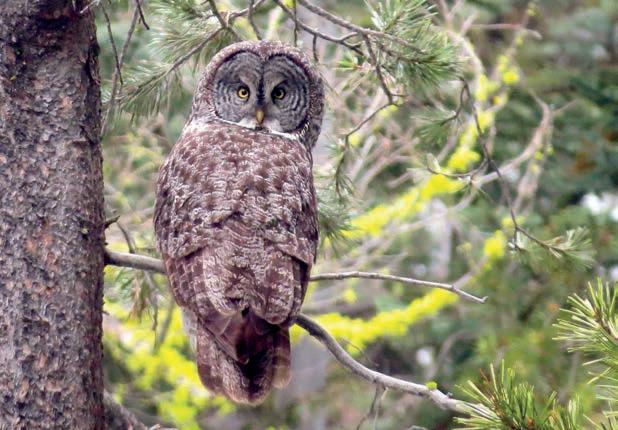
Yosemite provides a haven for two-thirds of California’s great gray owls, and harbors a distinct subspecies, Strix nebulosa Yosemitensis. RIGHT Thanks to you, scientists are learning how wildfire transforms the habitats and breeding behaviors of Yosemite’s spotted owls.


Share your love for Yosemite this holiday season with a gift from the Yosemite Conservancy Bookstore. Every purchase helps us preserve and protect Yosemite for generations to come.
Conservancy donors receive a 15% discount with code HOLIDAY2016 *
YOSEMITE INSIDER PHOTOS: (LEFT) © COURTESY OF NPS. (RIGHT) © KURT ONGMAN.
YOSEMITECONSERVANCY.ORG :: AUTUMN.WINTER 2016 15
ABOVE
*Code valid through Jan. 31, 2017; online purchases only. Shop
yosemiteconservancy.org/shop
now at
Give the Gift of Yosemite

PROTECTING YOSEMITE’S GIANTS
UPDATES ON THE RESTORATION OF MARIPOSA GROVE
n 1855, carpenter Galen Clark walked among the giant sequoias in Mariposa Grove for the first time. Imagine that moment: Clark dwarfed by massive trees, steeped in a tranquility broken only by the tap of a woodpecker or wind rustling through branches. From that day forward, he pushed for the trees’ protection, later serving as the first state-appointed custodian of Mariposa Grove and Yosemite Valley.
A century and a half later, the Mariposa Grove of Giant Sequoias had changed. Roads laced through the trees; rumbling vehicles replaced natural serenity. Now, thanks to you, the Conservancy is working with the National Park Service on a multiyear restoration effort to ensure this iconic forest continues to thrive, so that today’s seedlings grow into 1,000-yearold giants towering over countless future generations of visitors.
With your support, the Conservancy has contributed $20 million toward the restoration project, matching funding provided by the
GRANT UPDATES 16 AUTUMN.WINTER 2016 :: YOSEMITECONSERVANCY.ORG
LEFT Smooth-surfaced trails to the Grizzly Giant and California Tunnel Tree let visitors of all abilities see iconic sequoias up close.
Next summer, you’ll find the Grove transformed back into a peaceful, majestic cathedral.
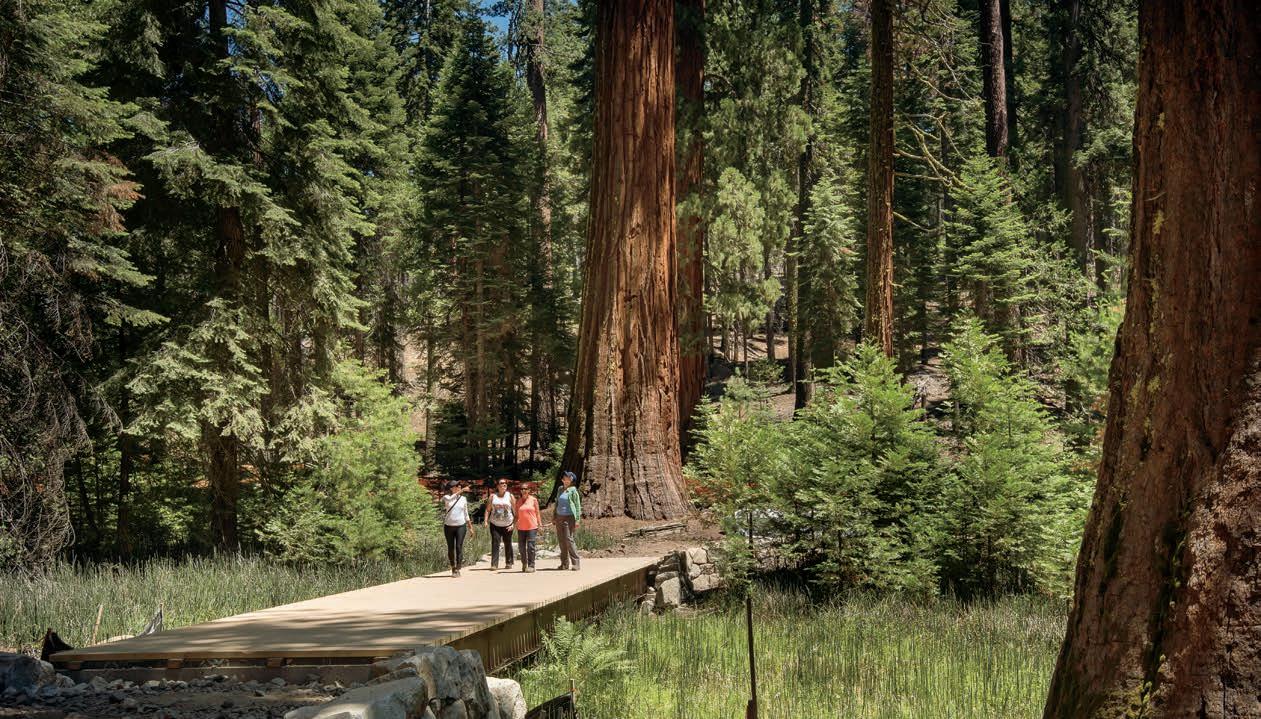
ABOVE When Mariposa Grove reopens to the public in 2017, visitors will find a carefully designed system of trails and boardwalks that allows people to experience the majesty of the trees in a tranquil, inspiring setting, far from the hum of traffic. RIGHT Visitors can touch a slice of history on this section of a naturally-felled giant sequoia log, with rings dating from 1215 to 1950. FAR RIGHT Volunteers and youth conservation crews have helped clear acres of invasive plants to restore the natural ecology. BELOW A new footbridge provides a tranquil path over sensitive habitat, protecting the plants and soil below.
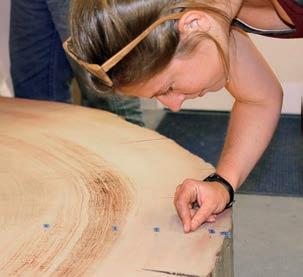

National Park Service. Work crews broke ground in June 2014. When work wraps up next summer, you’ll find the Grove transformed once again — this time, back into the peaceful, majestic cathedral that helped inspire Clark in the 1850s. As work continues, your gifts are already making a difference in Mariposa Grove.
Thank you to the many generous donors who have supported this multiyear transformation.

GRANT UPDATES YOSEMITECONSERVANCY.ORG :: AUTUMN.WINTER 2016 17
PHOTOS: (LEFT) © NANCY ROBBINS. (ABOVE) © JOSH HELLING. (RIGHT & BELOW) © CLAIRE F. MEYLER. (FAR RIGHT) © COURTESY OF NPS.

SURVEYING FOR BIGHORN SHEEP
WILDLIFE TEAMS MONITOR YOSEMITE’S NEW BIGHORN HERD


ast year, a herd of endangered Sierra Nevada bighorn was released into the Cathedral Range, marking the species’ return to Yosemite’s heart after a 100year absence. Now, thanks to continued support from Conservancy donors, who have funded 18 bighorn-related grants throughout the years, scientists are tracking the herd and working toward the long-term goal of establishing a self-sustaining bighorn sheep population in the center of Yosemite.
In 2016, wildlife biologists used GPS technology and field surveys to monitor the sheep’s movements, to confirm lambs had survived the winter, and to search for signs of predators, such as golden eagles and mountain lions. In one memorable moment, our project coordinator caught a glimpse of a bighorn ram on a rocky slope near Washburn Lake, blending perfectly with its surroundings, as if Muir’s cherished animal alpinists had been there all along.
With your support, these iconic mammals are reclaiming their place in the Yosemite Wilderness.
Thank you to Joan Egrie for generously providing funds in support of this project.
GRANT UPDATES 18 AUTUMN.WINTER 2016 :: YOSEMITECONSERVANCY.ORG
TOP Bighorn sheep have adapted to thrive in the rocky, high-elevation terrain of the Sierra Nevada. MIDDLE Yosemite biologists use powerful scopes to search for endangered sheep and their predators. BOTTOM A special sight from a 2016 survey: A bighorn ram perched on a steep cliff.
PHOTOS: (TOP) © STEVE YEAGER. (MIDDLE & BOTTOM) © YOSEMITE CONSERVANCY. PHOTOS: (TOP) © KEITH WALKLET. (BOTTOM) © COURTESY OF NPS.

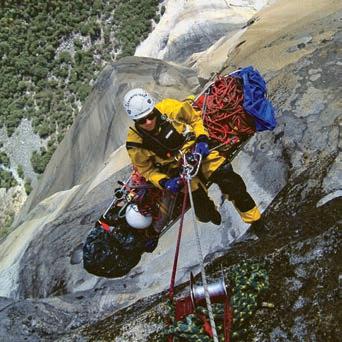
TOP New, elevated canvas tent cabins, complete with bear-proof lockers, serve as comfortable seasonal homes for Search and Rescue volunteers.
BOTTOM The “SAR-siters” provide vital support for hundreds of emergency operations each year, including technical rescues on Yosemite’s big walls.
Head to our blog to meet a 2016 SAR-siter at yosemiteconservancy.org/ blog/living-small-making-abig-difference
NEW SHELTER FOR CAMP 4
REPLACING TENT CABINS FOR SEARCH AND RESCUE VOLUNTEERS
ach spring, rock-climbers stream into Yosemite’s walk-in Camp 4. Most are there to explore the park’s world-famous walls, but a handful have an even bigger challenge ahead: Serving as “SAR-siters,” the volunteers who support Yosemite’s Search and Rescue efforts.
During their six months on the team, SAR-siters contribute to a range of emergency-response missions, from assisting lost hikers, to performing swiftwater rescues, to helping climbers stranded on steep rock faces. They rest up for expeditions in their seasonal homes: canvas cabins in Camp 4.
Living in these tent cabins helps promote camaraderie and provides easy access to the rescue-equipment cache, but after more than a decade of use and harsh weather, some of the cabins have fallen into disrepair. Gifts from Conservancy donors in 2015 and 2016 helped replace four cabins with new structures that provide SAR-siters with a comfortable, protected place to live, as they donate their time and skills to keep visitors safe.
Thank you to Jim and Kay Stiles for generously providing funds in support of this project.
GRANT UPDATES YOSEMITECONSERVANCY.ORG :: AUTUMN.WINTER 2016 19
PRESERVING PARK HISTORY
YOSEMITE CREWS RESTORE A TRIO OF
CENTURY-OLD BUILDINGS


he Pioneer Yosemite History Center, created in the 1950s and 1960s, consists of historic structures from different eras of Yosemite’s history. This year, with your support, crews are using special preservation techniques to restore three structures from the past:
1879: Rancher Jeremiah Hodgdon built a cabin in Aspen Valley, becoming one of many settlers who claimed land in the Yosemite area before it was named a national park.
1910: Wells Fargo erected an office in Yosemite Valley, where visitors to the 20-year-old park purchased stage-coach tickets and sent telegrams.
1915: Civilian rangers, key figures in the pre–National Park Service era, moved into a new patrol cabin at Crane Flat.
Donors, such as you, are helping to save pieces of the park’s past, so future visitors will be able to relive the human history of Yosemite’s early years as a protected landscape.
The Crane Flat cabin, built 101 years ago to house civilian rangers, is one of three historic Yosemite structures restored this year.
New woodwork will help preserve the 106-year-old Wells Fargo Office, a hub for Yosemite visitors in the early 1900s.
GRANT UPDATES 20 AUTUMN.WINTER 2016 :: YOSEMITECONSERVANCY.ORG PHOTOS: © YOSEMITE CONSERVANCY. PHOTOS: (TOP) © NANCY ROBBINS. (BOTTOM) © YOSEMITE CONSERVANCY.
A SENSE OF YOSEMITE


“When we actively seek a connection and bond with a place … we are no longer alone in nature but, rather, part of the natural world that envelops us.”
—
MAS MASUMOTO
“When does Yosemite become our Yosemite?”
hat question anchors one of Mas Masumoto’s essays in A Sense of Yosemite, a new collection of prose and photos from the Conservancy’s publishing team.
A Central Valley organic fruit grower and renowned author, Masumoto’s writing is rooted in the land around his 80-acre farm. That land is Yosemite, the home of photographer Nancy Robbins, who has spent years capturing the Sierra’s natural beauty. In this book, Robbins and Masumoto draw readers into the park through the sensory and seasonal experiences of two people whose lives are steeped in granite slopes, hushed forests and wildflower meadows.
The collection isn’t just about their sense of the park; it’s about our Yosemite. As Masumoto writes, that phrase evokes a sense of a common domain, of taking responsibility for the future of our public lands. Read his musings. Get lost in her breathtaking images. Emerge with a sense of wonder at this special place — and in our shared role to preserve it for the future.
Proceeds from this book, and from all Yosemite Conservancy retail items, support important work in the park. To purchase, visit one of our bookstores in Yosemite, or shop online at yosemiteconservancy.org/shop
PUBLISHING
YOSEMITECONSERVANCY.ORG :: AUTUMN.WINTER 2016 21
ESSAYS AND PHOTOS SHED FRESH LIGHT ON A FAMILIAR PLACE

AUTUMN ART
ARTIST TIPS FOR FALL PAINTING


ong after waterfalls and flowers have faded for the year, autumn glides into Yosemite in a breath of crisp air, golden meadows and red dogwoods. As the park calms after summer, fall is a perfect time to slow down with the season, and spend some time capturing Sierra scenery on paper.
Wondering where to start? Pam Pederson, an instructor for the Conservancy’s art workshops in the Valley, recommends finding a spot along the Merced River, where you can see Half Dome mirrored in slow-flowing water. Dip into greens and yellows to illustrate chartreuse plants and dark pines, and apply paint to damp paper (“weton-wet”) to capture their soft reflections. Let the sun warm your shoulders, but bring a poncho to keep yourself and your masterpiece dry in case of rain.
Our expert artists know how to capture Yosemite’s beauty in any season. Join us next year (April–October) for an outdoor workshop in the park.
Check out our art workshop schedule online at yosemiteconservancy.org/artcenter2017
PROGRAM UPDATES 22 AUTUMN.WINTER 2016 :: YOSEMITECONSERVANCY.ORG
©
ABOVE Participants in the Conservancy’s art workshops learn to capture seasonal scenery during outdoor drawing and painting sessions. RIGHT Paintings by Pam Pederson, a Conservancy art instructor, capture the experience of exploring Yosemite in autumn. PHOTOS: (LEFT) © KEITH WALKLET. (RIGHT)
PAM PEDERSON.
PHOTOS: (TOP) © CINNIE CHOU. (BOTTOM) © YOSEMITE CONSERVANCY.

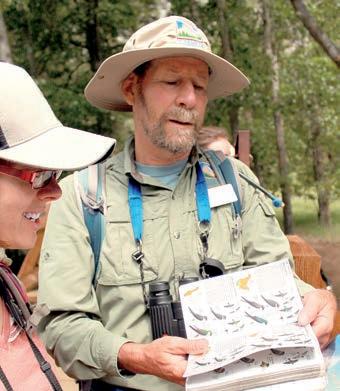
TOP During a high country hike, Outdoor Adventure participants learn about the ecology and history of surrounding peaks, meadows and waterways. BOTTOM What bird is that? Ask a naturalist! Conservancy guides use expertise in diverse topics, including ornithology, to create enriching programs.
GUIDED BY AN INSIDER
LEARN FROM EXPERTS ON NATURE-FOCUSED ADVENTURES
t’s easy to zoom through Yosemite’s highlights with a simple guidebook and map. Half Dome: check. Sequoias: check. Waterfalls: check. If you want to go beyond the basics, though, you need an insider’s perspective.
Enter the Conservancy’s naturalist guides, who take you to little-trafficked places, focus more on fueling curiosity than filling Instagram feeds, and show you how your gifts make a difference in Yosemite. Many of our naturalist guides have more than three decades of experience in the park, with expertise in subjects such as forestry, botany and geology. They lead adventures as varied as day hikes in the footsteps of famed ranger-naturalist Carl Sharsmith, hands-on bird-banding demonstrations, and relaxed backpacking treks to explore alpine animal habitats.
Nearly a century ago, we launched the first national park field school. Today, thanks to Outdoor Adventures, visitors continue to benefit from immersive experiences that stretch minds, not just muscles, and underscore the part we all play in preserving the park.
Find your adventure: See our full 2017 schedule of Outdoor Adventures at yosemiteconservancy.org/outdoor-adventures
PROGRAM UPDATES YOSEMITECONSERVANCY.ORG :: AUTUMN.WINTER 2016 23
2015 Annual Report HIGHLIGHTS
Your gifts make an impact!
AS A CONSERVANCY DONOR, you play a vital role in Yosemite. The 41 new grants you funded in 2015 transformed trails, restored habitat for plants and animals, created enriching visitor experiences, and more. And by volunteering, participating in our in-park programs and shopping in our bookstores, you deepened your connection to the park, while supporting projects that preserve and protect its resources.
With enormous gratitude, we share selected highlights from a successful 2015. Thank you for ensuring Yosemite’s future.
Total support to Yosemite surpassed
MATURE SEQUOIAS
(and thousands of seedlings) will thrive for generations, thanks to a multiyear restoration project in Mariposa Grove.
including gifts from more than , donors.

24 AUTUMN.WINTER 2016 :: YOSEMITECONSERVANCY.ORG
,,
MILES OF TRAILS
Backpackers helped keep bears wild by renting from the Conservancy.
More than benefited from the work of world-class crews.

connected with Yosemite Conservancy through in-park programs, bookstores and wilderness services. PARK VISITORS

More than YEAR S.
More than explored nature and stewardship through donor-funded Youth in Yosemite Programs.
Sierra Nevada bighorn sheep returned to their ancestral Cathedral Range habitat for the first time in
YOSEMITECONSERVANCY.ORG :: AUTUMN.WINTER 2016 25
,
, YOUNG
,
PEOPLE
BEAR-PROOF CANISTERS
For the full Annual Report and financial information, visit yosemiteconservancy.org/annualreport

“With Yosemite, we have so much wonder and beauty right in our backyard.”
— ALI MEGHDADI Yosemite Conservancy Donor

Honoring Love, Loving Yosemite
Couple says “I do” with gifts to the Conservancy
hat do you give to the couple that has everything? How about a gift that keeps on giving — for this generation and the next?
When Jenny Augustyn and Ali Meghdadi wed on Dec. 31, 2015, they asked friends and family to make gifts in their honor to Yosemite Conservancy in lieu of store-bought presents. Ali explained: “Neither of us needed a toaster. This way, people made a gift that felt special, and we shared our love of Yosemite.”
For this outdoorsy couple, asking for gifts in their honor helped loved ones feel connected to their new union. A self-described pair of “rock-climbers,
WHY I GIVE 26 AUTUMN.WINTER 2016 :: YOSEMITECONSERVANCY.ORG
LEFT Jenny Augustyn and Ali Meghdadi: The perfect picture of a couple in love – with each other, and with Yosemite!




naturalists, animal-lovers and hikers,” Jenny and Ali each held fond memories of climbing Half Dome (separately) in their teen years. Together, they return often to Yosemite to climb, hike and enjoy Conservancy gatherings. Of the wedding-tribute gifts, Jenny says: “For us, it was the pinnacle of everything we hold dear: gathering together the people in our lives, sharing environmental awareness and supporting this organization we hold in great esteem.”
Wedding guests were inspired by the couple’s request. At the reception, friends and family shared stories of fond memories in the park. Ali and Jenny hope the shared memories and experiences prompted their loved ones to keep visiting Yosemite — and to keep giving.
“With Yosemite, we have so much wonder and beauty right in our backyard,” Ali explains. Jenny adds: “To give back, to invest in nature — this is what matters to us. We hope others want to get involved, too.”
RIGHT Jenny and Ali’s wedding guests shared memories of Yosemite, and were inspired by the couple’s request to support the park. The gift-request cards, reprinted here, bear the likeness of a mighty giant sequoia.
Would you like to celebrate an important milestone with gifts in your honor, made to Yosemite Conservancy?
Please contact Isabelle Luebbers at 415-434-8446 x313 or iluebbers@yosemiteconservancy.org or visit yosemiteconservancy.org/ milestone
WHY I GIVE YOSEMITECONSERVANCY.ORG :: AUTUMN.WINTER 2016 27
PHOTOS (LEFT TO RIGHT): © JENNY AUGUSTYN & ALI MEGHDADI. © KIRI BECHER. © JENNY AUGUSTYN & ALI MEGHDADI.
MIDDLE For Sierra-smitten outdoor enthusiasts Jenny and Ali, asking wedding guests to donate to the Conservancy was a natural choice.

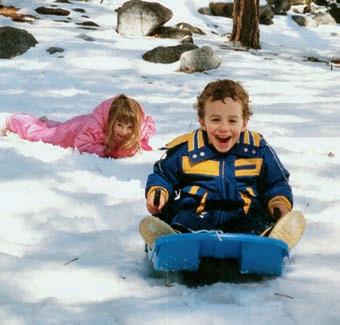
Giving Back to a Yosemite Home
Valley doctor has the perfect prescription for giving
or Dr. Gary Flashner, supporting Yosemite is a passion. As a newlywed in the 1980s, Gary and his wife honeymooned in Yosemite and fell in love with the park; he asked for a job in the Yosemite Medical Clinic. “It was an amazing opportunity to raise a family in the most pristine environment, with a wonderful community,” he says.
Gary witnessed firsthand how Conservancy donors make a difference in the park. Inspired, he has generously supported the Conservancy as a member of the John Muir Heritage Society, giving monthly via the Sequoia Society, and by donating his expertise.
An expert in trauma and wilderness medicine, Gary helped create risk-management manuals for the Outdoor Adventures program and the wilderness patrol staff. He says, “I jumped at the chance to give back!”
As a member of the Joseph Le Conte Legacy Society, Gary continues to give back, with a planned gift to the Conservancy. “Places like Yosemite have been set aside for our generation, the next and the future,” he says. “If we have a true commitment to these sacred places, it’s critical we support organizations like Yosemite Conservancy.”
“Places like Yosemite have been set aside for our generation, the next and the future.”
— DR. GARY FLASHNER Yosemite Conservancy Donor
28 AUTUMN.WINTER 2016 :: YOSEMITECONSERVANCY.ORG WHY I GIVE
PHOTOS: © GARY FLASHNER.
ABOVE Conservancy
donor Dr. Gary Flashner has shared his love for the Sierra Nevada wilderness with children, Katie and Matt. RIGHT While raising his family in Yosemite, Gary got to enjoy the park in every season — and grew inspired to give back.
Donor Events & Activities
THE JOHN MUIR HERITAGE SOCIETY is a community of generous Yosemite Conservancy supporters who have demonstrated a strong commitment to protecting and preserving Yosemite for future generations. With your annual gift of $1,000 or more, you join the influential group of Conservancy donors responsible for the completion of many critical projects in the park each year. Support at this level has tremendous impact, and your leadership gifts enable Yosemite Conservancy to truly make a difference in the park. Join now, and enjoy benefits such as invitations to exclusive events with park staff, an insider’s view of the park, special recognition, and a community of like-minded individuals.
For more information about the John Muir Heritage Society or events, please contact Kim Coull at 415-434-8446 x324 or kcoull@yosemiteconservancy.org


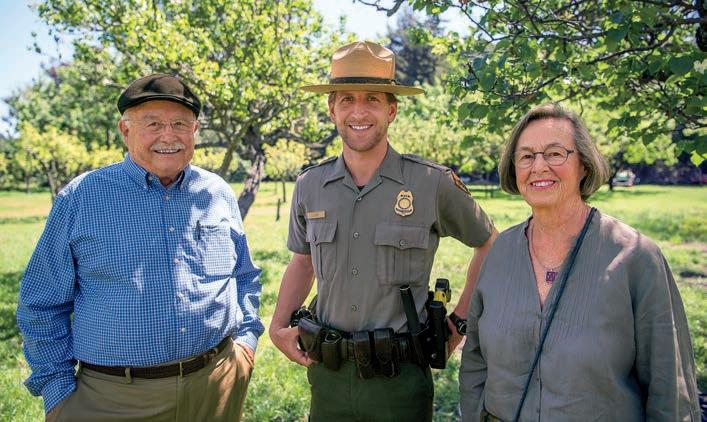

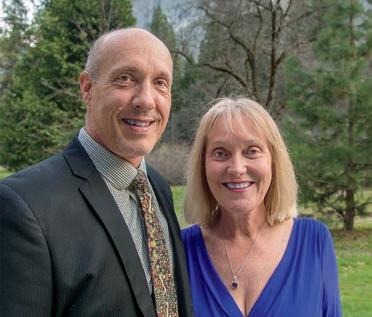



DONOR EVENTS
Ackerson Meadow hike led by naturalist Dan Webster
Steve & Beth Bangert learn about Hetch Hetchy
Jerry Edelbrock, Polly & Ward Wolff
Kerstin Edgerton, Sy Kaufman, Bonnie Gregory & Sharon Pillsbury
David & Shirley Reha
Ron & Ann Berg
John Houghton & Patti Johns Eisenberg
Robert & Roberta Geering with Justin Fey
Spring Colors
Spring Colors Comstock Wines
Northern California Luncheon
Northern California Luncheon
Spring Gathering
Spring Gathering
YOSEMITECONSERVANCY.ORG :: AUTUMN.WINTER 2016 29
Spring Gathering
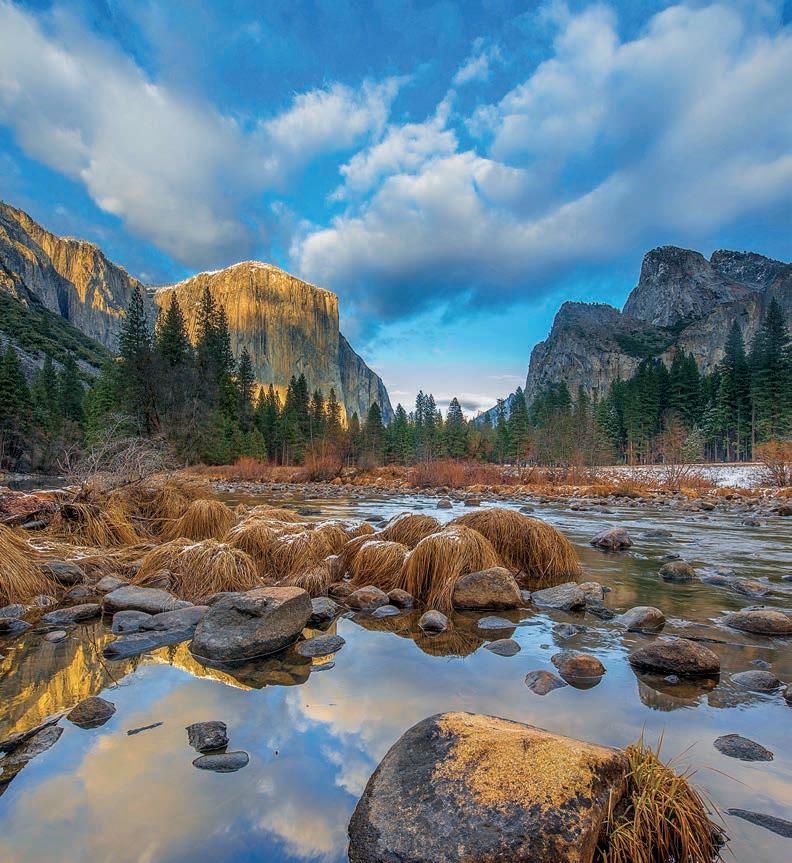



04 03 01 02 READER PHOTOS Join Yosemite Conservancy via social media and share your favorite Yosemite pictures, or email your photo submission to community@yosemiteconservancy.org YOSEMITE’S MAJESTY AS CAPTURED BY OUR SUPPORTERS
30 AUTUMN.WINTER 2016 :: YOSEMITECONSERVANCY.ORG 01 Valley View in the Winter PHOTO BY © REETOM HAZARIKA 02 Dusted Dogwoods PHOTO BY © DAVE WEBER 03 Clean Bobcat PHOTO BY © KIEL MADDOX 04 Dewey Point PHOTO BY © ROWENA LUBO Share your Yosemite photos with the Conservancy! Join us on Flickr, and tag your favorite photos with #yosemiteconnect. Our staff chooses photos to print in each issue of Yosemite Conservancy, as well as selected “Photo of the Month” images on our website and in our enewsletter.
YOSEMITE THROUGH YOUR LENS
YOSEMITE
CONSERVANCY
Magazine of Yosemite Conservancy, published twice a year.
EDITORIAL DIRECTOR
Jennifer Miller
ASSISTANT EDITOR
Claire F. Meyler
CONTRIBUTING WRITERS
Frank Dean Claire F. Meyler
Stephanie Eyes Gretchen Roecker
Mike McDonald
DESIGN PRINT PRODUCTION
Eric Ball Design TradeMark Graphics, Inc.
STAFF :: San Francisco
Frank Dean, President & CEO
Jerry Edelbrock, Vice President, CFO & COO
Kim Coull, Development Director
Edin Draper-Beard, Executive Affairs Manager
Kevin Gay, Finance Director
Jamie Lilly, Events Director
Debra Holcomb, Planned Giving Director
Sara Jones, Institutional Giving Officer
Holly Kuehn, Development & Donor Services Assistant
Isabelle Luebbers, Annual Giving Director
Claire F. Meyler, Communications Manager & Webmaster
Jennifer Miller, Marketing & Communications Director
Eryn Roberts, Data Services Assistant
Gretchen Roecker, Communications & Social Media Manager
Jonathan Roybal, Major Gifts Officer
Kiely Smith, Data Assistant
STAFF :: Yosemite
Adonia Ripple, General Manager, Yosemite Operations
Greg Archer, Valley Sales Supervisor
Nicole Brocchini, Museum Store Supervisor
Kylie Chappell, Outdoor Adventures Coordinator
Pete Devine, Resident Naturalist
Teresa Ellis, Sales Information Assistant
Schuyler Greenleaf, Projects Director
Suzy Hasty, Volunteer Program Manager
Cory Jacobs, Inventory Coordinator
Ryan Kelly, Projects Coordinator
Olotumi Laizer, Valley Complex Supervisor
Katie Manion, Retail Operations Manager
Cassie May, Outreach & Wholesale Coordinator
Michael Ross, Naturalist
Angela Sberna, Accounting Director
Mark Scrimenti, Lead Wilderness Reservation Assistant
Shelly Stephens, Inventory Manager
Laurie Stowe, Wilderness Programs Manager
Samantha Walsh, Yosemite Art Center Coordinator
STAFF :: Southern California & National
Patti Johns Eisenberg, Major Gifts Officer
Autumn.Winter 2016 :: Volume 07. Issue 02 ©2016
Federal Tax Identification No. 94-3058041
Ways to Give
THERE ARE MANY WAYS you and your organization can support the meaningful work of Yosemite Conservancy. We look forward to exploring these philanthropic opportunities with you.
CONTACT US
Visit yosemiteconservancy.org
Email info@yosemiteconservancy.org
Phone 415-434-1782
INDIVIDUAL GIVING
Development Director
Kim Coull kcoull@yosemiteconservancy.org 415-434-8446 x324
Annual Giving
Isabelle Luebbers iluebbers@yosemiteconservancy.org 415-434-8446 x313
Major Gifts – Northern California
Jonathan Roybal jroybal@yosemiteconservancy.org 415-434-8446 x318
Major Gifts – Southern California & National
Patti Johns Eisenberg peisenberg@yosemiteconservancy.org 626-792-9626
FOUNDATIONS & CORPORATIONS
Sara Jones sjones@yosemiteconservancy.org 415-434-8446 x328
PLANNED GIVING & BEQUESTS
Debra Holcomb dholcomb@yosemiteconservancy.org 415-434-8446 x319
Mail
Yosemite Conservancy 101 Montgomery Street, Suite 1700 San Francisco, CA 94104
Fax
415-434-0745
HONOR & MEMORIAL GIFTS
Isabelle Luebbers iluebbers@yosemiteconservancy.org 415-434-8446 x313
GIFTS OF STOCK
Eryn Roberts stock@yosemiteconservancy.org 415-434-8446 x330
SEQUOIA SOCIETY MONTHLY GIVING
Isabelle Luebbers iluebbers@yosemiteconservancy.org 415-434-8446 x313
MATCHING GIFTS
Isabelle Luebbers iluebbers@yosemiteconservancy.org 415-434-8446 x313
VOLUNTEER OPPORTUNITIES
Suzy Hasty shasty@yosemiteconservancy.org 209-379-2317 yosemiteconservancy.org/volunteer
DONOR GUIDE
YOSEMITECONSERVANCY.ORG :: AUTUMN.WINTER 2016 31
San Francisco, CA 94104

Yosemite Conservancy
1700
101 Montgomery Street, Suite
How will you remember Yosemite? Yosemite’s natural wonders are not only our inheritance, but also our responsibility. Your legacy gift to Yosemite Conservancy makes a lasting impact beyond your lifetime, commemorating your special connection to Yosemite while ensuring the park remains a beloved treasure for future generations to enjoy. To learn how you can leave your legacy to Yosemite, contact Debra Holcomb at dholcomb@yosemiteconservancy.org or 415-434-8446 x319. yosemiteconservancy.org/plannedgiving Follow the Conservancy on social media to stay in touch on the go. PHOTO: © KEITH WALKLET.














































































